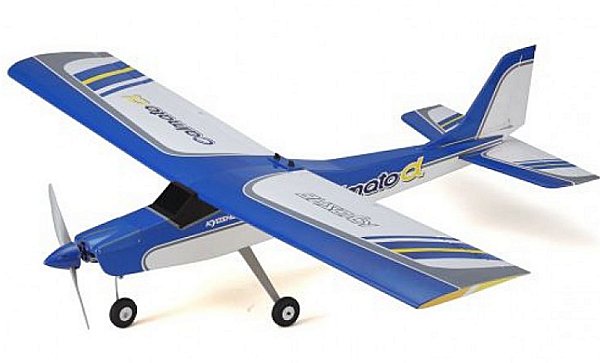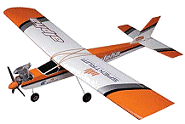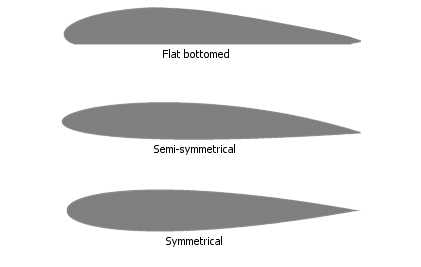*My website, RC Airplane World, is now for sale. Established 20+ years, big potential. Contact me through my contact page if you are interested!*
RC Trainer Airplanes
Radio control trainer planes ('trainers') are designed to make learning to fly as easy as possible. All trainers - regardless of power type - have the same basic characteristics which help you, the beginner rc pilot, greatly in your early days of radio control flying.
The most obvious of these characteristics are the high wing design and noticeable dihedral, which is the term that refers to the upward angle of the wing panels when viewed from the front.

Above: your typical rc trainer plane design.
This high wing and dihedral configuration gives a trainer airplane a lot of natural stability in the air which, generally speaking, results in very forgiving flight characteristics. Exactly what you need when learning to fly RC airplanes!
Electric powered (EP) rc trainer planes are readily available to buy in foam or balsa/ply construction, whereas internal combustion (IC) trainers are more commonly of balsa/ply.
Level of Completion
It's more common, these days, for rc trainer airplanes to be bought fully, or almost fully, completed. In the past, more would have been built from a kit.
There are several variations of completeness to choose from, the differences being:
- Kit: the plane needs building from a box of pieces, over a plan. You'll need to purchase quite a few extras and tools and have a good knowledge of model building techniques. Building from a kit is ultimately very rewarding, but lots of work.
- ARF: the plane will be about 90% finished, just needing some final assembly work done to complete it. You need to install the engine and radio gear yourself, having bought it separately from the kit (Learn more about ARFs).
- RTF: the plane is completely finished with engine and rc gear fully installed. You just need to buy batteries for the rc gear and do some very basic final assembly (Learn more about RTFs).
RTF Variations
For electric powered rc trainer airplanes, this last one - RTF - can be split into two further categories: PNP (Plug-N-Play) and BNF (Bind-N-Fly).
These types of planes are in Ready To Fly form but a PNP plane has no transmitter, receiver or motor battery pack included, whereas a BNF plane comes with a DSM2/DSMX-technology (i.e. Spektrum) compatible 2.4GHz receiver installed and is only lacking the transmitter.
Incidentally, the terms Plug-N-Play and Bind-N-Fly are registered trade marks of rc product distributors Horizon Hobby. Other manufacturers produce rc aircraft in similar states of readiness but use different descriptions, one example being "Receiver Ready".
So you can see that an RTF, or variant of, rc trainer airplane is the best choice if you just want to get flying with the least amount of fuss and in the shortest possible time.
An ARF or kit is a better choice if you want an introduction to the construction side of the hobby.
Why High Wing Planes make the Best Trainers
 Most rc trainer airplanes have a high wing for one simple reason - stability.
Most rc trainer airplanes have a high wing for one simple reason - stability.
In a high wing plane the weight of the fuselage below the wing will always act to stabilise the airplane in flight. After a turn, for example, the plane will naturally want to level itself because it is 'bottom heavy'.
Airplanes of this design are therefore perfect for the tyro radio control pilot.
 Low wing designs are of course the opposite; the airplane is 'top heavy' because the fuselage is above the wing and so the plane will not want to right itself so much. For this reason, planes of a low wing design aren't as stable as high wing planes, but they are more maneuverable.
Low wing designs are of course the opposite; the airplane is 'top heavy' because the fuselage is above the wing and so the plane will not want to right itself so much. For this reason, planes of a low wing design aren't as stable as high wing planes, but they are more maneuverable.
There are some low wing trainers available, of course, but they're not as common.
 Between those two types are the mid wing designs, where the wing is located approximately halfway between top and bottom of the fuselage. These airplanes give a good balance of stability and maneuverability and are perfectly suited to smooth aerobatic performance because of the generally symmetric design.
Between those two types are the mid wing designs, where the wing is located approximately halfway between top and bottom of the fuselage. These airplanes give a good balance of stability and maneuverability and are perfectly suited to smooth aerobatic performance because of the generally symmetric design.
The 'Extra' is a well known mid-wing airplane, but not really a trainer!
Other Factors to Consider
Wing Shape
When choosing between different rc airplanes, the cross-section wing shape (airfoil or aerofoil) is another factor to consider.
This airfoil section is the shape that you see when looking at the end of the wing. Although there are many different specific airfoil designs, all alphanumerically labelled, there are basically 3 common categories that you're most likely to experience in your early days of flying radio control airplanes - flat bottomed, semi-symmetrical and symmetrical shaped airfoils.
Simply put, an airplane with a flat bottomed airfoil will have the most lift at the slowest airspeed - obviously good for the beginner and the reason why many trainers feature this shape.
The disadvantage with this airfoil shape is that it creates relatively high drag.
A symmetrical airfoil provides equal amounts of lift regardless of whether the plane is right-side up or upside down - perfect for aerobatics.
An airplane with a semi-symmetrical airfoil holds advantages of both flat bottomed and symmetrical, so is ideal for the 'sport' type planes.
These 3 common airfoil shapes are (very approximately) illustrated below:

Two other airfoil sections that you might encounter are under-cambered and flat...

An under-cambered wing has its lower surface closely following the curve of the upper surface. Such airfoils are very efficient and create little drag.
The flat wing section has become increasingly common in recent years as more people build electric rc airplanes out of foam sheet, particularly Depron.
These 'shock fliers', or 'shockies', are a good example of planes that usually feature a completely flat airfoil. You almost certainly won't see a flat airfoil section on an rc trainer airplane though.
Flat wings don't generate lift in the usual way (see how airplanes fly) but rely on the Angle of Attack instead. Because of this, the drag created by these airfoils is the highest of all airfoil sections.
Dihedral
Dihedral is the upward 'V' angle of the wings from the fuselage, looking at the wings from the front.
Greater dihedral increases the airplane's stability, up to a point, as the plane will naturally want to centre itself to its lowest point.
RC airplanes that are designed for aerobatics will have very little or no dihedral, so maneuvers can be executed without the tendency for the plane to keep righting itself.
RC airplanes that are designed to be trainers will always have noticeable dihedral.
Another important point about dihedral is that planes with rudder-only directional control (i.e. no ailerons) will always have more dihedral than planes with ailerons.
This is because dihedral, during a rudder-only turn, effectively does the job of the ailerons and rolls (banks) the plane. That's an overly simplified version of events, but the effect is known as Dihedral Effect, should you wish to research it further.

Landing Gear (Undercarriage)
While some rc planes have no landing gear, there are two choices otherwise; tricycle or taildragger.
Airplanes with a tricycle landing gear ('trike') have two main wheels beneath the cockpit area and a nose wheel, which may be linked to the rudder servo to give accurate steering control on the ground.
The trike undercarriage plane is, generally speaking, easier to maneuver on the ground, making it better suited to beginners.
A taildragger has the same two main wheels but instead of a nose wheel has a much smaller wheel located beneath the fin, which may or may not be steerable. Taildraggers can be harder to maneuver on the ground but the lack of nose wheel means slightly less weight and less drag in the air.

Of course, the type of landing gear will be determined by your choice of plane - for example, a Piper Cub will always be a taildragger whereas most non-scale trainers will likely be trikes.
RC Trainer Plane Technology
In recent times, electronic stabilization systems have found their way into some rc trainers.
Leading the way is Horizon Hobby with their SAFE™ technology ("Sensor Assisted Flight Envelope").
There are arguments for and against and I have mixed views - on the one hand it does make learning to fly an RC plane easier, especially if you're self-teaching. On the other hand, it can lead the beginner in to a false sense of security.
Thankfully, such technology (bundled into the plane's receiver software) has various options for different levels of aid, including disabling it completely for either when you've learned to fly the plane confidently, or you just don't want the electronic help whilst learning.
Such electronic stabilization technology essentially prevents the plane getting in to an unwanted attitude. For example, it will limit the bank angle of the turns, or prevent steep dives.
Flicking a switch on the transmitter will change the amount of stabilization that it gives, or turn it off completely.
Should you consider an rc trainer plane with such technology?
The 'old school' side of me says "No, learn the hard way like I did!" but the practical side of me says "Yes, of course!" - especially if you intent to self-teach.
So hopefully this article has given you an idea of what an rc trainer airplane is.
It's important that you consider this type of plane as your first and that you don't rush out and buy something unsuitable for learning on. The correct choice of your first rc plane is going to have a profound effect on your enjoyment of and success in the hobby of radio control flying!
